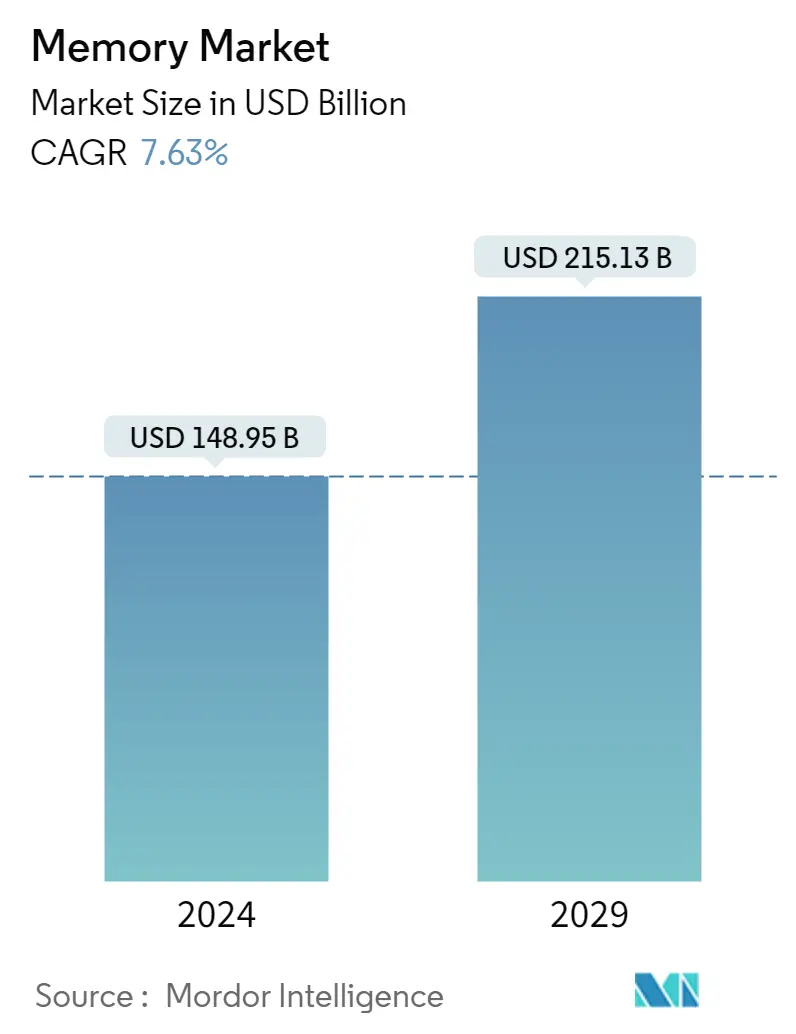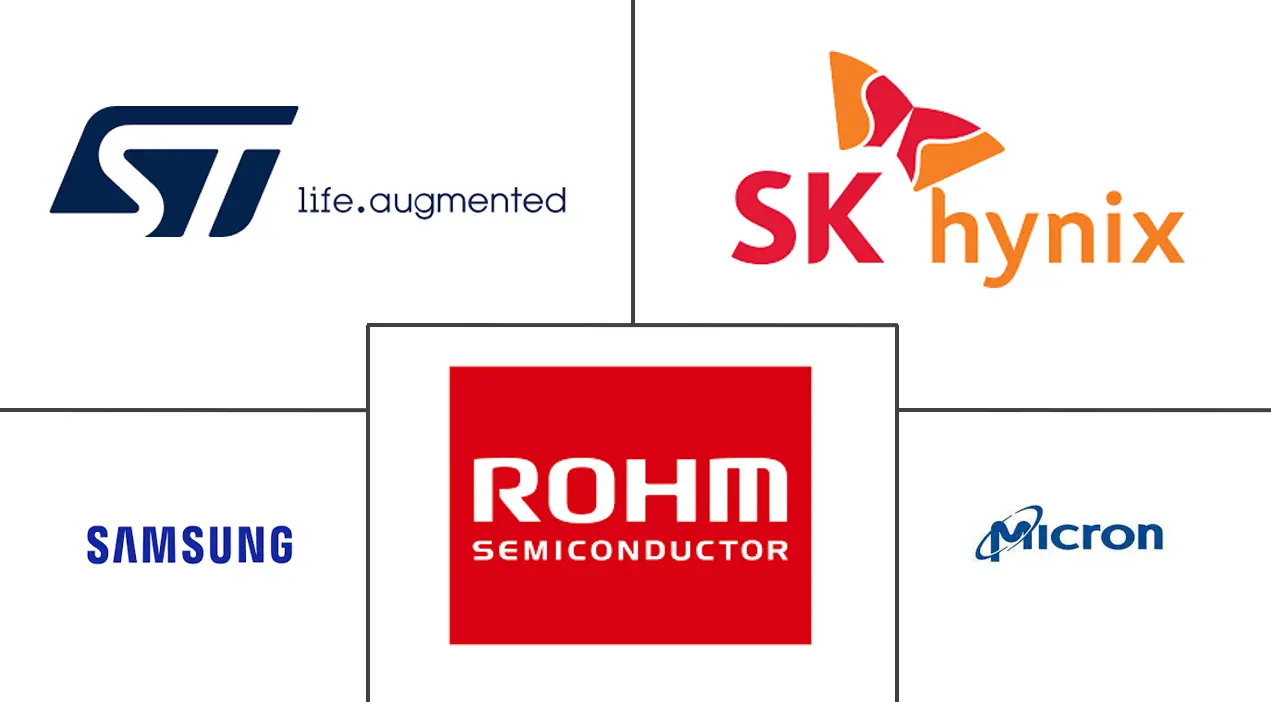Market Size of Memory Industry

| Study Period | 2019 - 2029 |
| Market Size (2024) | USD 148.95 Billion |
| Market Size (2029) | USD 215.13 Billion |
| CAGR (2024 - 2029) | 7.63 % |
| Fastest Growing Market | Asia-Pacific |
| Largest Market | North America |
Major Players
*Disclaimer: Major Players sorted in no particular order |
Memory Market Analysis
The Memory Market size is estimated at USD 148.95 billion in 2024, and is expected to reach USD 215.13 billion by 2029, growing at a CAGR of 7.63% during the forecast period (2024-2029).
The COVID-19 pandemic across the globe significantly disrupted the supply chain and production of the market studies in the initial phase of 2020. For fabrication units, this impact was more severe. Owing to the labor shortages, many of the package, assembly, and testing plants in the Asia Pacific region reduced and even suspended operations. This created a bottleneck for end-user companies that depend on semiconductors. More recently, COVID-19-related lockdowns in China again disrupted the Global Memory Market supply chain. In December 2021, Samsung Electronics and Micron Technology, two of the world's largest memory chip producers, warned that strict COVID-19 curbs and lockdowns in the Chinese city of Xian might disrupt their chip manufacturing bases in the area. According to Micron Technology, the lockdowns could cause delays in the supply of DRAM memory chips, widely used in data centers.
The memory market is witnessing rapid growth, with semiconductors emerging as the basic building blocks of most modern technologies. The innovations and advancements in this market are resulting in a direct impact on all downstream technologies.
The National Cable and Telecommunications Association projected that the number of connected devices in 2020 will be around 50.1 billion. Every IoT or IIoTdevice contains sophisticated semiconductor memory chips that permit devices to achieve remote connectivity. Moreover, as the IoT is poised to grow significantly, it is expected to impact the growth of the memory market as well.
By 2025, the market is set to experience significant benefits from the ongoing development and innovation in the automotive industry, connectivity, communications, and data centers. The rise in the consumption of electronic components used in the navigation of safety, infotainment, and automobiles further contributes to the market's growth.
Semiconductor memory products are used extensively across electronic devices, such as smartphones, flat-screen monitors, LED TVs, and civil aerospace and military systems. The memory industry is also likely to benefit from progress in biometrics capabilities. The growing demand for smartphones and technologically advanced products, such as wearable gadgets, etc., is also accelerating the growth of the market studied.
Further, several vendors are investing in this technology to gain an advantage. For instance, in April 2022, Keysight Technologies, Inc., a leading technology company that provides advanced design and validation solutions, announced that SK Hynix selected Keysight's integrated peripheral component to interconnect express (PCIe) 5.0 test platforms for speeding up the development of memory semiconductors used for designing advanced products capable of managing huge data and supporting high data speeds and.
Memory Industry Segmentation
The scope of the study focuses on the market analysis of semiconductor memory and market sizing encompasses the revenue generated by the memory products across the end-user industry. The study also tracks the key market parameters, underlying growth influencers, and major vendors operating in the industry, which supports the market estimations and growth rates over the forecast period. The study tracks the revenue accrued from the different memory market players operating across the world. The study further analyzes the overall impact of COVID-19 on the ecosystem.
| By Type | |
| DRAM | |
| SRAM | |
| NOR Flash | |
| NAND Flash | |
| ROM & EPROM | |
| Others |
| By Application | |
| Consumer Products | |
| PC/Laptop | |
| Smartphone/Tablet | |
| Data Center | |
| Automotive | |
| Other Applications |
| By Geography | |
| Americas | |
| Europe | |
| China | |
| Japan | |
| Asia-Pacific |
Memory Market Size Summary
The memory market is experiencing robust growth, driven by the increasing demand for semiconductors, which are integral to modern technologies. This sector has been significantly impacted by global events such as the COVID-19 pandemic, which disrupted supply chains and production, particularly in the Asia Pacific region. The pandemic's effects were felt across the industry, with major players like Samsung Electronics and Micron Technology facing challenges due to lockdowns in China. Despite these disruptions, the market is poised for expansion, fueled by advancements in IoT, IIoT, and the automotive industry, as well as the growing need for memory in data centers and connected devices. The rise in electronic components for navigation, safety, and infotainment systems in vehicles further propels market growth.
Technological innovations in memory products are enhancing their capabilities, allowing for greater data storage at reduced costs. Companies like Nantero and United Microelectronics Corporation are leading developments in non-volatile memory technologies, which are expected to see increased adoption due to their efficiency and performance benefits. The demand for memory is also rising in consumer electronics, including smartphones, wearable devices, and gaming consoles, as well as in industrial applications such as factory automation. The competitive landscape of the memory market is characterized by strategic partnerships and investments from major players like Samsung, Micron, and SK Hynix, who are expanding their manufacturing capabilities and exploring new technologies to maintain their market positions.
Memory Market Size - Table of Contents
-
1. MARKET DYNAMICS
-
1.1 Market Drivers
-
1.1.1 Rising Penetration of 5G and IoT Devices
-
1.1.2 Growing Memory Requirement in Data Centers
-
1.1.3 Rising Demand from Consumer Electronics and Automotive Sectors
-
-
1.2 Market Challenges
-
1.2.1 Short term supply chain challenges due to the pandemic scenario and the US-China Trade war scenario
-
-
-
2. MARKET SEGMENTATION
-
2.1 By Type
-
2.1.1 DRAM
-
2.1.2 SRAM
-
2.1.3 NOR Flash
-
2.1.4 NAND Flash
-
2.1.5 ROM & EPROM
-
2.1.6 Others
-
-
2.2 By Application
-
2.2.1 Consumer Products
-
2.2.2 PC/Laptop
-
2.2.3 Smartphone/Tablet
-
2.2.4 Data Center
-
2.2.5 Automotive
-
2.2.6 Other Applications
-
-
2.3 By Geography
-
2.3.1 Americas
-
2.3.2 Europe
-
2.3.3 China
-
2.3.4 Japan
-
2.3.5 Asia-Pacific
-
-
Memory Market Size FAQs
How big is the Memory Market?
The Memory Market size is expected to reach USD 148.95 billion in 2024 and grow at a CAGR of 7.63% to reach USD 215.13 billion by 2029.
What is the current Memory Market size?
In 2024, the Memory Market size is expected to reach USD 148.95 billion.

